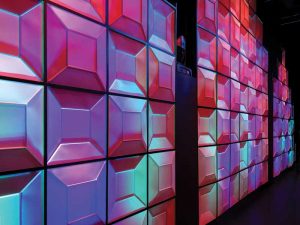
By Ed Davis, Ben Carr, and Steven H. Miller, CDT
A suspended (drop-in) luminous grid ceiling is a multi-functional architectural element that forms a major decorative surface. It keeps unsightly overhead mechanical services concealed but accessible, while hosting lighting and other fixtures and providing thermal/acoustic control.
In the middle of the 20th century, the ceiling itself started to be used as a source of illumination. Luminous ceilings, composed of fluorescent troffers above the ceiling that shone down through light-transmitting ceiling panels, were all the rage. The concept is now having a resurgence—updated and improved by the use of light-emitting diode (LED) light sources that deliver more versatile illumination at much greater energy efficiency.
Luminous ceilings have benefits for numerous different applications, ranging from banquet halls to offices and hospitals. Light-transmitting panels, available in a range of decorative patterns and sized for “universal” grids, offer the designer opportunities to create simplified yet beautified ceilings with versatile functionality.
Function
Luminous ceilings typically provide even, diffused illumination in the space below them. Unlike point sources of light, this illumination comes from an infinite number of angles, reducing or eliminating shadows. Light intensity is dependent on output of light sources and spacing of those sources above the ceiling. With LEDs, output is often variable and controllable. RBGW (red, blue, green, white) LEDs also allow the color to be changed in a range of hues. Some control systems even allow light levels to be pre-programmed for different parts of the day or for specific events.
While there are other types of luminous ceilings, such as stretched fabric, suspended grid ceilings offer the highest versatility and functionality, while being an affordable option. Similar to opaque drop-in ceilings, the luminous versions conceal unsightly mechanical services above the ceiling plane (e.g. HVAC ducts, electrical and IT raceways, plumbing, etc.), but allow easy access to them for maintenance or repair. If drop-out panels are used, even fire suppression sprinkler systems can be removed from view. This is further discussed in the ‘design considerations’ section of this article.
A luminous ceiling is ideal in situations where diffuse light is desirable. It can be either the primary light source, or a background wash of light—including colored light—that supplements point sources.




